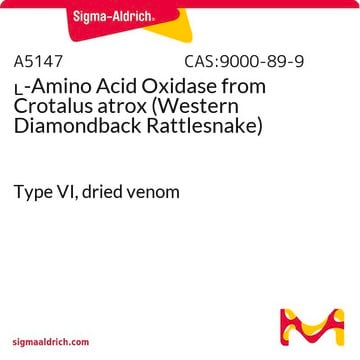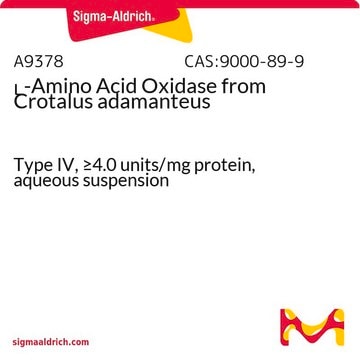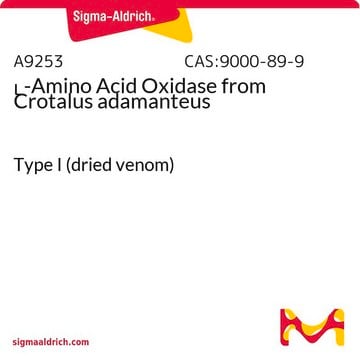This product should be stored at -20 °C as a powder. Information on storing the product in solution is not available, and it is recommended to prepare the product fresh before use.
A5222
D-Amino Acid Oxidase from porcine kidney
powder, ≥1.5 units/mg solid
Synonym(s):
D-AAO, D-Amino acid: oxygen oxidoreductase (deaminating)
Select a Size
Select a Size
About This Item
Recommended Products
form
powder
specific activity
≥1.5 units/mg solid
storage temp.
−20°C
Looking for similar products? Visit Product Comparison Guide
Application
Unit Definition
Storage Class Code
11 - Combustible Solids
WGK
WGK 3
Flash Point(F)
Not applicable
Flash Point(C)
Not applicable
Personal Protective Equipment
Choose from one of the most recent versions:
Certificates of Analysis (COA)
Don't see the Right Version?
If you require a particular version, you can look up a specific certificate by the Lot or Batch number.
Already Own This Product?
Find documentation for the products that you have recently purchased in the Document Library.
Customers Also Viewed
-
If I store it at -4 degrees Celsius instead of -20 degrees Celsius, will the enzyme denature so much that it cannot be used? Also, if I expose it to room temperature for use in an experiment and then store it at -4 degrees Celsius, will it be usable again
1 answer-
Helpful?
-
-
Hello, I am doing my research about D-amino acid oxidase from porcine kidney. For further calculations I need molar extinction coefficient of pkDAAO. Maybe You have bigger description or some kind of information about it? Thank You.
1 answer-
There are two extinction coefficient values available:
Assuming all Cys residues form cystines - 1.935 at 280 nm in water, 0.1% (1 g/L)
Assuming all Cys residues are reduced - 1.929 at 280 nm in water, 0.1% (1 g/L)Please see the link below to review this and additional information available at Expasy:
https://web.expasy.org/cgi-bin/protparam/protparam1?P00371@noft@Helpful?
-
Active Filters
Our team of scientists has experience in all areas of research including Life Science, Material Science, Chemical Synthesis, Chromatography, Analytical and many others.
Contact Technical Service












